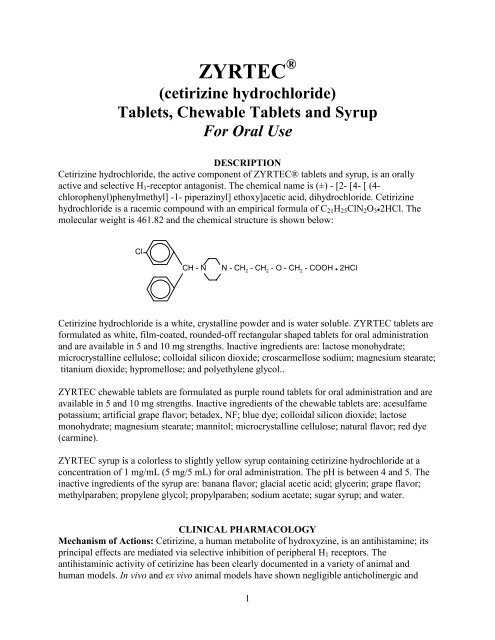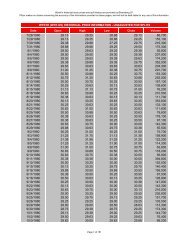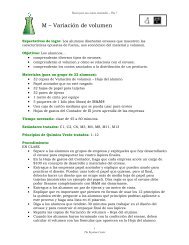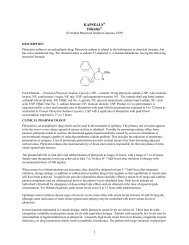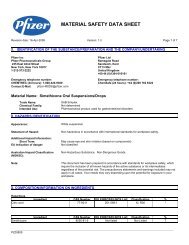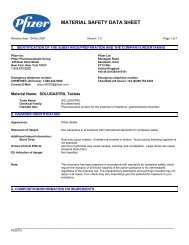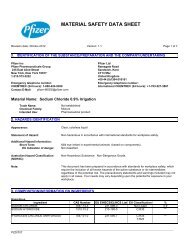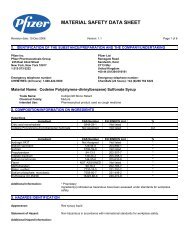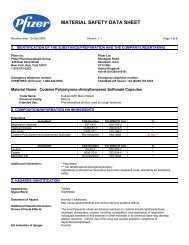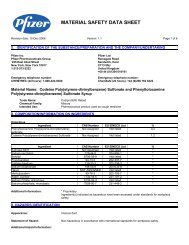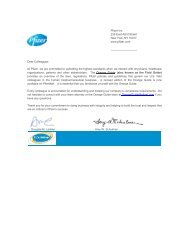ZYRTEC® (cetirizine Hydrochloride) Tablets, Chewable ... - Pfizer
ZYRTEC® (cetirizine Hydrochloride) Tablets, Chewable ... - Pfizer
ZYRTEC® (cetirizine Hydrochloride) Tablets, Chewable ... - Pfizer
You also want an ePaper? Increase the reach of your titles
YUMPU automatically turns print PDFs into web optimized ePapers that Google loves.
ZYRTEC ®<br />
(<strong>cetirizine</strong> hydrochloride)<br />
<strong>Tablets</strong>, <strong>Chewable</strong> <strong>Tablets</strong> and Syrup<br />
For Oral Use<br />
DESCRIPTION<br />
Cetirizine hydrochloride, the active component of ZYRTEC® tablets and syrup, is an orally<br />
active and selective H1-receptor antagonist. The chemical name is (±) - [2- [4- [ (4chlorophenyl)phenylmethyl]<br />
-1- piperazinyl] ethoxy]acetic acid, dihydrochloride. Cetirizine<br />
hydrochloride is a racemic compound with an empirical formula of C21H25ClN2O3•2HCl. The<br />
molecular weight is 461.82 and the chemical structure is shown below:<br />
Cl<br />
CH - N N - CH 2 - CH 2 - O - CH 2 - COOH • 2HCl<br />
Cetirizine hydrochloride is a white, crystalline powder and is water soluble. ZYRTEC tablets are<br />
formulated as white, film-coated, rounded-off rectangular shaped tablets for oral administration<br />
and are available in 5 and 10 mg strengths. Inactive ingredients are: lactose monohydrate;<br />
microcrystalline cellulose; colloidal silicon dioxide; croscarmellose sodium; magnesium stearate;<br />
titanium dioxide; hypromellose; and polyethylene glycol..<br />
ZYRTEC chewable tablets are formulated as purple round tablets for oral administration and are<br />
available in 5 and 10 mg strengths. Inactive ingredients of the chewable tablets are: acesulfame<br />
potassium; artificial grape flavor; betadex, NF; blue dye; colloidal silicon dioxide; lactose<br />
monohydrate; magnesium stearate; mannitol; microcrystalline cellulose; natural flavor; red dye<br />
(carmine).<br />
ZYRTEC syrup is a colorless to slightly yellow syrup containing <strong>cetirizine</strong> hydrochloride at a<br />
concentration of 1 mg/mL (5 mg/5 mL) for oral administration. The pH is between 4 and 5. The<br />
inactive ingredients of the syrup are: banana flavor; glacial acetic acid; glycerin; grape flavor;<br />
methylparaben; propylene glycol; propylparaben; sodium acetate; sugar syrup; and water.<br />
CLINICAL PHARMACOLOGY<br />
Mechanism of Actions: Cetirizine, a human metabolite of hydroxyzine, is an antihistamine; its<br />
principal effects are mediated via selective inhibition of peripheral H1 receptors. The<br />
antihistaminic activity of <strong>cetirizine</strong> has been clearly documented in a variety of animal and<br />
human models. In vivo and ex vivo animal models have shown negligible anticholinergic and<br />
1
antiserotonergic activity. In clinical studies, however, dry mouth was more common with<br />
<strong>cetirizine</strong> than with placebo. In vitro receptor binding studies have shown no measurable affinity<br />
for other than H1 receptors. Autoradiographic studies with radiolabeled <strong>cetirizine</strong> in the rat have<br />
shown negligible penetration into the brain. Ex vivo experiments in the mouse have shown that<br />
systemically administered <strong>cetirizine</strong> does not significantly occupy cerebral H1 receptors.<br />
Pharmacokinetics:<br />
Absorption: Cetirizine was rapidly absorbed with a time to maximum concentration (Tmax) of<br />
approximately 1 hour following oral administration of tablets, chewable tablets or syrup in<br />
adults. Comparable bioavailability was found between the tablet and syrup dosage forms.<br />
Comparable bioavailability was also found between the ZYRTEC tablet and the ZYRTEC<br />
chewable tablet taken with or without water. When healthy volunteers were administered<br />
multiple doses of <strong>cetirizine</strong> (10 mg tablets once daily for 10 days), a mean peak plasma<br />
concentration (Cmax) of 311 ng/mL was observed. No accumulation was observed. Cetirizine<br />
pharmacokinetics were linear for oral doses ranging from 5 to 60 mg. Food had no effect on the<br />
extent of exposure (AUC) of the <strong>cetirizine</strong> tablet or chewable tablet, but Tmax was delayed by<br />
1.7 hours and 2.8 hours respectively, and Cmax was decreased by 23% and 37%, respectively in<br />
the presence of food.<br />
Distribution: The mean plasma protein binding of <strong>cetirizine</strong> is 93%, independent of<br />
concentration in the range of 25-1000 ng/mL, which includes the therapeutic plasma levels<br />
observed.<br />
Metabolism: A mass balance study in 6 healthy male volunteers indicated that 70% of the<br />
administered radioactivity was recovered in the urine and 10% in the feces. Approximately 50%<br />
of the radioactivity was identified in the urine as unchanged drug. Most of the rapid increase in<br />
peak plasma radioactivity was associated with parent drug, suggesting a low degree of first-pass<br />
metabolism. Cetirizine is metabolized to a limited extent by oxidative O-dealkylation to a<br />
metabolite with negligible antihistaminic activity. The enzyme or enzymes responsible for this<br />
metabolism have not been identified.<br />
Elimination: The mean elimination half-life in 146 healthy volunteers across multiple<br />
pharmacokinetic studies was 8.3 hours and the apparent total body clearance for <strong>cetirizine</strong> was<br />
approximately 53 mL/min.<br />
Interaction Studies<br />
Pharmacokinetic interaction studies with <strong>cetirizine</strong> in adults were conducted with<br />
pseudoephedrine, antipyrine, ketoconazole, erythromycin and azithromycin. No interactions were<br />
observed. In a multiple dose study of theophylline (400 mg once daily for 3 days) and <strong>cetirizine</strong><br />
(20 mg once daily for 3 days), a 16% decrease in the clearance of <strong>cetirizine</strong> was observed. The<br />
disposition of theophylline was not altered by concomitant <strong>cetirizine</strong> administration.<br />
Special Populations<br />
Pediatric Patients: When pediatric patients aged 7 to 12 years received a single, 5-mg oral<br />
<strong>cetirizine</strong> capsule, the mean Cmax was 275 ng/mL. Based on cross-study comparisons, the<br />
2
weight-normalized, apparent total body clearance was 33% greater and the elimination half-life<br />
was 33% shorter in this pediatric population than in adults. In pediatric patients aged 2 to 5 years<br />
who received 5 mg of <strong>cetirizine</strong>, the mean Cmax was 660 ng/mL. Based on cross-study<br />
comparisons, the weight-normalized apparent total body clearance was 81 to 111% greater and<br />
the elimination half-life was 33 to 41% shorter in this pediatric population than in adults. In<br />
pediatric patients aged 6 to 23 months who received a single dose of 0.25 mg/kg <strong>cetirizine</strong> oral<br />
solution (mean dose 2.3 mg), the mean Cmax was 390 ng/mL. Based on cross-study<br />
comparisons, the weight-normalized, apparent total body clearance was 304% greater and the<br />
elimination half-life was 63% shorter in this pediatric population compared to adults. The<br />
average AUC(0-t) in children 6 months to
Dosing adjustment may be necessary in patients with hepatic impairment (see DOSAGE AND<br />
ADMINISTRATION).<br />
Pharmacodynamics: Studies in 69 adult normal volunteers (aged 20 to 61 years) showed that<br />
ZYRTEC at doses of 5 and 10 mg strongly inhibited the skin wheal and flare caused by the<br />
intradermal injection of histamine. The onset of this activity after a single 10-mg dose occurred<br />
within 20 minutes in 50% of subjects and within one hour in 95% of subjects; this activity<br />
persisted for at least 24 hours. ZYRTEC at doses of 5 and 10 mg also strongly inhibited the<br />
wheal and flare caused by intradermal injection of histamine in 19 pediatric volunteers (aged 5 to<br />
12 years) and the activity persisted for at least 24 hours. In a 35-day study in children aged 5 to<br />
12, no tolerance to the antihistaminic (suppression of wheal and flare response) effects of<br />
ZYRTEC was found. In 10 infants 7 to 25 months of age who received 4 to 9 days of <strong>cetirizine</strong> in<br />
an oral solution (0.25 mg/kg bid), there was a 90% inhibition of histamine-induced (10 mg/mL)<br />
cutaneous wheal and 87% inhibition of the flare 12 hours after administration of the last dose.<br />
The clinical relevance of this suppression of histamine-induced wheal and flare response on skin<br />
testing is unknown.<br />
The effects of intradermal injection of various other mediators or histamine releasers were also<br />
inhibited by <strong>cetirizine</strong>, as was response to a cold challenge in patients with cold-induced<br />
urticaria. In mildly asthmatic subjects, ZYRTEC at 5 to 20 mg blocked bronchoconstriction due<br />
to nebulized histamine, with virtually total blockade after a 20-mg dose. In studies conducted for<br />
up to 12 hours following cutaneous antigen challenge, the late phase recruitment of eosinophils,<br />
neutrophils and basophils, components of the allergic inflammatory response, was inhibited by<br />
ZYRTEC at a dose of 20 mg.<br />
In four clinical studies in healthy adult males, no clinically significant mean increases in QTc<br />
were observed in ZYRTEC treated subjects. In the first study, a placebo-controlled crossover<br />
trial, ZYRTEC was given at doses up to 60 mg per day, 6 times the maximum clinical dose, for<br />
1 week, and no significant mean QTc prolongation occurred. In the second study, a crossover<br />
trial, ZYRTEC 20 mg and erythromycin (500 mg every 8 hours) were given alone and in<br />
combination. There was no significant effect on QTc with the combination or with ZYRTEC<br />
alone. In the third trial, also a crossover study, ZYRTEC 20 mg and ketoconazole (400 mg per<br />
day) were given alone and in combination. ZYRTEC caused a mean increase in QTc of 9.1 msec<br />
from baseline after 10 days of therapy. Ketoconazole also increased QTc by 8.3 msec. The<br />
combination caused an increase of 17.4 msec, equal to the sum of the individual effects. Thus,<br />
there was no significant drug interaction on QTc with the combination of ZYRTEC and<br />
ketoconazole. In the fourth study, a placebo-controlled parallel trial, ZYRTEC 20 mg was given<br />
alone or in combination with azithromycin (500 mg as a single dose on the first day followed by<br />
250 mg once daily). There was no significant increase in QTc with ZYRTEC 20 mg alone or in<br />
combination with azithromycin.<br />
In a four-week clinical trial in pediatric patients aged 6 to 11 years, results of randomly obtained<br />
ECG measurements before treatment and after 2 weeks of treatment showed that ZYRTEC 5 or<br />
10 mg did not increase QTc versus placebo. In a one week clinical trial (N=86) of ZYRTEC<br />
syrup (0.25 mg/kg bid) compared with placebo in pediatric patients 6 to 11 months of age, ECG<br />
4
measurements taken within 3 hours of the last dose did not show any ECG abnormalities or<br />
increases in QTc interval in either group compared to baseline assessments. Data from other<br />
studies where ZYRTEC was administered to patients 6-23 months of age were consistent with<br />
the findings in this study.<br />
The effects of ZYRTEC on the QTc interval at doses higher than 10 mg have not been studied in<br />
children less than 12 years of age.<br />
In a six-week, placebo-controlled study of 186 patients (aged 12 to 64 years) with allergic rhinitis<br />
and mild to moderate asthma, ZYRTEC 10 mg once daily improved rhinitis symptoms and did<br />
not alter pulmonary function. In a two-week, placebo-controlled clinical trial, a subset analysis of<br />
65 pediatric (aged 6 to 11 years) allergic rhinitis patients with asthma showed ZYRTEC did not<br />
alter pulmonary function. These studies support the safety of administering ZYRTEC to pediatric<br />
and adult allergic rhinitis patients with mild to moderate asthma.<br />
Clinical Studies: Nine multicenter, randomized, double-blind, clinical trials comparing<br />
<strong>cetirizine</strong> 5 to 20 mg to placebo in patients 12 years and older with seasonal or perennial allergic<br />
rhinitis were conducted in the United States. Five of these showed significant reductions in<br />
symptoms of allergic rhinitis, 3 in seasonal allergic rhinitis (1 to 4 weeks in duration) and 2 in<br />
perennial allergic rhinitis for up to 8 weeks in duration. Two 4-week multicenter, randomized,<br />
double-blind, clinical trials comparing <strong>cetirizine</strong> 5 to 20 mg to placebo in patients with chronic<br />
idiopathic urticaria were also conducted and showed significant improvement in symptoms of<br />
chronic idiopathic urticaria. In general, the 10-mg dose was more effective than the 5-mg dose<br />
and the 20-mg dose gave no added effect. Some of these trials included pediatric patients aged 12<br />
to 16 years. In addition, four multicenter, randomized, placebo-controlled, double-blind 2-4 week<br />
trials in 534 pediatric patients aged 6 to 11 years with seasonal allergic rhinitis were conducted in<br />
the United States at doses up to 10 mg.<br />
INDICATIONS AND USAGE<br />
Seasonal Allergic Rhinitis: ZYRTEC is indicated for the relief of symptoms associated with<br />
seasonal allergic rhinitis due to allergens such as ragweed, grass and tree pollens in adults and<br />
children 2 years of age and older. Symptoms treated effectively include sneezing, rhinorrhea,<br />
nasal pruritus, ocular pruritus, tearing, and redness of the eyes.<br />
Perennial Allergic Rhinitis: ZYRTEC is indicated for the relief of symptoms associated with<br />
perennial allergic rhinitis due to allergens such as dust mites, animal dander and molds in adults<br />
and children 6 months of age and older. Symptoms treated effectively include sneezing,<br />
rhinorrhea, postnasal discharge, nasal pruritus, ocular pruritus, and tearing.<br />
Chronic Urticaria: ZYRTEC is indicated for the treatment of the uncomplicated skin<br />
manifestations of chronic idiopathic urticaria in adults and children 6 months of age and older. It<br />
significantly reduces the occurrence, severity, and duration of hives and significantly reduces<br />
pruritus.<br />
5
CONTRAINDICATIONS<br />
ZYRTEC is contraindicated in those patients with a known hypersensitivity to it or any of its<br />
ingredients or hydroxyzine.<br />
PRECAUTIONS<br />
Activities Requiring Mental Alertness: In clinical trials, the occurrence of somnolence has<br />
been reported in some patients taking ZYRTEC; due caution should therefore be exercised when<br />
driving a car or operating potentially dangerous machinery. Concurrent use of ZYRTEC with<br />
alcohol or other CNS depressants should be avoided because additional reductions in alertness<br />
and additional impairment of CNS performance may occur.<br />
Drug-Drug Interactions: No clinically significant drug interactions have been found with<br />
theophylline at a low dose, azithromycin, pseudoephedrine, ketoconazole, or erythromycin. There<br />
was a small decrease in the clearance of <strong>cetirizine</strong> caused by a 400-mg dose of theophylline; it is<br />
possible that larger theophylline doses could have a greater effect.<br />
Carcinogenesis, Mutagenesis and Impairment of Fertility: In a 2-year carcinogenicity study in<br />
rats, <strong>cetirizine</strong> was not carcinogenic at dietary doses up to 20 mg/kg (approximately 15 times the<br />
maximum recommended daily oral dose in adults on a mg/m 2 basis, or approximately 7 times the<br />
maximum recommended daily oral dose in infants on a mg/m 2 basis). In a 2-year carcinogenicity<br />
study in mice, <strong>cetirizine</strong> caused an increased incidence of benign liver tumors in males at a<br />
dietary dose of 16 mg/kg (approximately 6 times the maximum recommended daily oral dose in<br />
adults on a mg/m 2 basis, or approximately 3 times the maximum recommended daily oral dose in<br />
infants on a mg/m 2 basis). No increase in the incidence of liver tumors was observed in mice at a<br />
dietary dose of 4 mg/kg (approximately 2 times the maximum recommended daily oral dose in<br />
adults on a mg/m 2 basis, or approximately equivalent to the maximum recommended daily oral<br />
dose in infants on a mg/m 2 basis). The clinical significance of these findings during long-term<br />
use of ZYRTEC is not known.<br />
Cetirizine was not mutagenic in the Ames test, and not clastogenic in the human lymphocyte<br />
assay, the mouse lymphoma assay, and in vivo micronucleus test in rats.<br />
In a fertility and general reproductive performance study in mice, <strong>cetirizine</strong> did not impair<br />
fertility at an oral dose of 64 mg/kg (approximately 25 times the maximum recommended daily<br />
oral dose in adults on a mg/m 2 basis).<br />
Pregnancy Category B: In mice, rats, and rabbits, <strong>cetirizine</strong> was not teratogenic at oral doses up<br />
to 96, 225, and 135 mg/kg, respectively (approximately 40, 180 and 220 times the maximum<br />
recommended daily oral dose in adults on a mg/m 2 basis). There are, however, no adequate and<br />
well-controlled studies in pregnant women. Because animal reproduction studies are not always<br />
predictive of human response, ZYRTEC should be used during pregnancy only if clearly needed.<br />
6
Nursing Mothers: In mice, <strong>cetirizine</strong> caused retarded pup weight gain during lactation at an oral<br />
dose in dams of 96 mg/kg (approximately 40 times the maximum recommended daily oral dose<br />
in adults on a mg/m 2 basis). Studies in beagle dogs indicated that approximately 3% of the dose<br />
was excreted in milk. Cetirizine has been reported to be excreted in human breast milk. Because<br />
many drugs are excreted in human milk, use of ZYRTEC in nursing mothers is not<br />
recommended.<br />
Geriatric Use: Of the total number of patients in clinical studies of ZYRTEC, 186 patients were<br />
65 years and older, and 39 patients were 75 years and older. No overall differences in safety<br />
were observed between these patients and younger patients, but greater sensitivity of some older<br />
individuals cannot be ruled out. With regard to efficacy, clinical studies of ZYRTEC for each<br />
approved indication did not include sufficient numbers of patients aged 65 years and older to<br />
determine whether they respond differently than younger patients.<br />
ZYRTEC is known to be substantially excreted by the kidney, and the risk of toxic reactions to<br />
this drug may be greater in patients with impaired renal function. Because elderly patients are<br />
more likely to have decreased renal function, care should be taken in dose selection, and it may<br />
be useful to monitor renal function. (See Geriatric Patients and Renal Impairment subsections<br />
in CLINICAL PHARMACOLOGY.)<br />
Pediatric Use: The safety of ZYRTEC has been demonstrated in pediatric patients aged 6<br />
months to 11 years. The safety of ZYRTEC, at daily doses of 5 or 10 mg, has been demonstrated<br />
in 376 pediatric patients aged 6 to 11 years in placebo-controlled trials lasting up to four weeks<br />
and in 254 patients in a non-placebo-controlled 12-week trial. The safety of <strong>cetirizine</strong> has been<br />
demonstrated in 168 patients aged 2 to 5 years in placebo-controlled trials of up to 4 weeks<br />
duration. On a mg/kg basis, most of the 168 patients received between 0.2 and 0.4 mg/kg of<br />
<strong>cetirizine</strong> HCl. The safety of <strong>cetirizine</strong> in 399 patients aged 12 to 24 months has been<br />
demonstrated in a placebo-controlled 18-month trial, in which the average dose was 0.25 mg/kg<br />
bid, corresponding to a range of 4 to 11 mg/day. The safety of ZYRTEC syrup has been<br />
demonstrated in 42 patients aged 6 to 11 months in a placebo-controlled 7-day trial. The<br />
prescribed dose was 0.25 mg/kg bid, which corresponded to a mean of 4.5 mg/day, with a range<br />
of 3.4 to 6.2 mg/day.<br />
The effectiveness of ZYRTEC for the treatment of allergic rhinitis and chronic idiopathic<br />
urticaria in pediatric patients aged 6 months to 11 years is based on an extrapolation of the<br />
demonstrated efficacy of ZYRTEC in adults with these conditions and the likelihood that the<br />
disease course, pathophysiology and the drug’s effect are substantially similar between these two<br />
populations. Efficacy is extrapolated down to 6 months of age for perennial allergic rhinitis and<br />
down to 2 years of age for seasonal allergic rhinitis because these diseases are thought to occur<br />
down to these ages in children. The recommended doses for the pediatric population are based on<br />
cross-study comparisons of the pharmacokinetics and pharmacodynamics of <strong>cetirizine</strong> in adult<br />
and pediatric subjects and on the safety profile of <strong>cetirizine</strong> in both adult and pediatric patients at<br />
doses equal to or higher than the recommended doses. The <strong>cetirizine</strong> AUC and Cmax in pediatric<br />
subjects aged 6 to 23 months who received a mean of 2.3 mg in a single dose, and in subjects<br />
aged 2 to 5 years who received a single dose of 5 mg of <strong>cetirizine</strong> syrup and in pediatric subjects<br />
7
aged 6 to 11 years who received a single dose of 10 mg of <strong>cetirizine</strong> syrup were estimated to be<br />
intermediate between that observed in adults who received a single dose of 10 mg of <strong>cetirizine</strong><br />
tablets and those who received a single dose of 20 mg of <strong>cetirizine</strong> tablets.<br />
The safety and effectiveness of <strong>cetirizine</strong> in pediatric patients under the age of 6 months have not<br />
been established.<br />
ADVERSE REACTIONS<br />
Controlled and uncontrolled clinical trials conducted in the United States and Canada included<br />
more than 6000 patients aged 12 years and older, with more than 3900 receiving ZYRTEC at<br />
doses of 5 to 20 mg per day. The duration of treatment ranged from 1 week to 6 months, with a<br />
mean exposure of 30 days.<br />
Most adverse reactions reported during therapy with ZYRTEC were mild or moderate. In<br />
placebo-controlled trials, the incidence of discontinuations due to adverse reactions in patients<br />
receiving ZYRTEC 5 or 10 mg was not significantly different from placebo (2.9% vs. 2.4%,<br />
respectively).<br />
The most common adverse reaction in patients aged 12 years and older that occurred more<br />
frequently on ZYRTEC than placebo was somnolence. The incidence of somnolence associated<br />
with ZYRTEC was dose related, 6% in placebo, 11% at 5 mg and 14% at 10 mg.<br />
Discontinuations due to somnolence for ZYRTEC were uncommon (1.0% on ZYRTEC vs. 0.6%<br />
on placebo). Fatigue and dry mouth also appeared to be treatment-related adverse reactions.<br />
There were no differences by age, race, gender or by body weight with regard to the incidence of<br />
adverse reactions.<br />
Table 1 lists adverse experiences in patients aged 12 years and older which were reported for<br />
ZYRTEC 5 and 10 mg in controlled clinical trials in the United States and that were more<br />
common with ZYRTEC than placebo.<br />
Table 1.<br />
Adverse Experiences Reported in Patients Aged 12 Years and Older in<br />
Placebo-Controlled United States ZYRTEC Trials (Maximum Dose of 10 mg)<br />
at Rates of 2% or Greater (Percent Incidence)<br />
Adverse ZYRTEC Placebo<br />
Experience (N=2034) (N=1612)<br />
Somnolence 13.7 6.3<br />
Fatigue 5.9 2.6<br />
Dry Mouth 5.0 2.3<br />
Pharyngitis 2.0 1.9<br />
Dizziness 2.0 1.2<br />
8
In addition, headache and nausea occurred in more than 2% of the patients, but were more<br />
common in placebo patients.<br />
Pediatric studies were also conducted with ZYRTEC. More than 1300 pediatric patients aged 6<br />
to 11 years with more than 900 treated with ZYRTEC at doses of 1.25 to 10 mg per day were<br />
included in controlled and uncontrolled clinical trials conducted in the United States. The<br />
duration of treatment ranged from 2 to 12 weeks. Placebo-controlled trials up to 4 weeks duration<br />
included 168 pediatric patients aged 2 to 5 years who received <strong>cetirizine</strong>, the majority of whom<br />
received single daily doses of 5 mg. A placebo-controlled trial 18 months in duration included<br />
399 patients aged 12 to 24 months treated with <strong>cetirizine</strong> (0.25 mg/kg bid), and another placebocontrolled<br />
trial of 7 days duration included 42 patients aged 6 to 11 months who were treated<br />
with <strong>cetirizine</strong> (0.25 mg/kg bid).<br />
The majority of adverse reactions reported in pediatric patients aged 2 to 11 years with ZYRTEC<br />
were mild or moderate. In placebo-controlled trials, the incidence of discontinuations due to<br />
adverse reactions in pediatric patients receiving up to 10 mg of ZYRTEC was uncommon (0.4%<br />
on ZYRTEC vs. 1.0% on placebo).<br />
Table 2 lists adverse experiences which were reported for ZYRTEC 5 and 10 mg in pediatric<br />
patients aged 6 to 11 years in placebo-controlled clinical trials in the United States and were<br />
more common with ZYRTEC than placebo. Of these, abdominal pain was considered<br />
treatment-related and somnolence appeared to be dose-related, 1.3% in placebo, 1.9% at 5 mg<br />
and 4.2% at 10 mg. The adverse experiences reported in pediatric patients aged 2 to 5 years in<br />
placebo-controlled trials were qualitatively similar in nature and generally similar in frequency to<br />
those reported in trials with children aged 6 to 11 years.<br />
In the placebo-controlled trials of pediatric patients 6 to 24 months of age, the incidences of<br />
adverse experiences were similar in the <strong>cetirizine</strong> and placebo treatment groups in each study.<br />
Somnolence occurred with essentially the same frequency in patients who received <strong>cetirizine</strong> and<br />
patients who received placebo. In a study of 1 week duration in children 6-11 months of age,<br />
patients who received <strong>cetirizine</strong> exhibited greater irritability/fussiness than patients on placebo.<br />
In a study of 18 months duration in patients 12 months and older, insomnia occurred more<br />
frequently in patients who received <strong>cetirizine</strong> compared to patients who received placebo (9.0%<br />
v. 5.3%). In those patients who received 5 mg or more per day of <strong>cetirizine</strong> as compared to<br />
patients who received placebo, fatigue (3.6% v. 1.3%) and malaise (3.6% v. 1.8%) occurred more<br />
frequently.<br />
9
Table 2.<br />
Adverse Experiences Reported in Pediatric Patients Aged 6 to 11 Years in<br />
Placebo-Controlled United States ZYRTEC Trials (5 or 10 mg Dose) Which Occurred at a<br />
Frequency of ≥2% in Either the 5-mg or the 10-mg ZYRTEC Group, and More Frequently<br />
Than in the Placebo Group<br />
ZYRTEC<br />
Adverse Experiences Placebo<br />
5 mg<br />
10 mg<br />
(N=309)<br />
(N=161)<br />
(N=215)<br />
Headache 12.3% 11.0% 14.0%<br />
Pharyngitis 2.9% 6.2% 2.8%<br />
Abdominal pain 1.9% 4.4% 5.6%<br />
Coughing 3.9% 4.4% 2.8%<br />
Somnolence 1.3% 1.9% 4.2%<br />
Diarrhea 1.3% 3.1% 1.9%<br />
Epistaxis 2.9% 3.7% 1.9%<br />
Bronchospasm 1.9% 3.1% 1.9%<br />
Nausea 1.9% 1.9% 2.8%<br />
Vomiting 1.0% 2.5% 2.3%<br />
The following events were observed infrequently (less than 2%), in either 3982 adults and<br />
children 12 years and older or in 659 pediatric patients aged 6 to 11 years who received ZYRTEC<br />
in U.S. trials, including an open adult study of six months duration. A causal relationship of these<br />
infrequent events with ZYRTEC administration has not been established.<br />
Autonomic Nervous System: anorexia, flushing, increased salivation, urinary retention.<br />
Cardiovascular: cardiac failure, hypertension, palpitation, tachycardia.<br />
Central and Peripheral Nervous Systems: abnormal coordination, ataxia, confusion,<br />
dysphonia, hyperesthesia, hyperkinesia, hypertonia, hypoesthesia, leg cramps, migraine, myelitis,<br />
paralysis, paresthesia, ptosis, syncope, tremor, twitching, vertigo, visual field defect.<br />
Gastrointestinal: abnormal hepatic function, aggravated tooth caries, constipation, dyspepsia,<br />
eructation, flatulence, gastritis, hemorrhoids, increased appetite, melena, rectal hemorrhage,<br />
stomatitis including ulcerative stomatitis, tongue discoloration, tongue edema.<br />
Genitourinary: cystitis, dysuria, hematuria, micturition frequency, polyuria, urinary<br />
incontinence, urinary tract infection.<br />
Hearing and Vestibular: deafness, earache, ototoxicity, tinnitus.<br />
Metabolic/Nutritional: dehydration, diabetes mellitus, thirst.<br />
10
Musculoskeletal: arthralgia, arthritis, arthrosis, muscle weakness, myalgia.<br />
Psychiatric: abnormal thinking, agitation, amnesia, anxiety, decreased libido, depersonalization,<br />
depression, emotional lability, euphoria, impaired concentration, insomnia, nervousness,<br />
paroniria, sleep disorder.<br />
Respiratory System: bronchitis, dyspnea, hyperventilation, increased sputum, pneumonia,<br />
respiratory disorder, rhinitis, sinusitis, upper respiratory tract infection.<br />
Reproductive: dysmenorrhea, female breast pain, intermenstrual bleeding, leukorrhea,<br />
menorrhagia, vaginitis.<br />
Reticuloendothelial: lymphadenopathy.<br />
Skin: acne, alopecia, angioedema, bullous eruption, dermatitis, dry skin, eczema, erythematous<br />
rash, furunculosis, hyperkeratosis, hypertrichosis, increased sweating, maculopapular rash,<br />
photosensitivity reaction, photosensitivity toxic reaction, pruritus, purpura, rash, seborrhea, skin<br />
disorder, skin nodule, urticaria.<br />
Special Senses: parosmia, taste loss, taste perversion.<br />
Vision: blindness, conjunctivitis, eye pain, glaucoma, loss of accommodation, ocular<br />
hemorrhage, xerophthalmia.<br />
Body as a Whole: accidental injury, asthenia, back pain, chest pain, enlarged abdomen, face<br />
edema, fever, generalized edema, hot flashes, increased weight, leg edema, malaise, nasal polyp,<br />
pain, pallor, periorbital edema, peripheral edema, rigors.<br />
Occasional instances of transient, reversible hepatic transaminase elevations have occurred<br />
during <strong>cetirizine</strong> therapy. Hepatitis with significant transaminase elevation and elevated bilirubin<br />
in association with the use of ZYRTEC has been reported.<br />
Post-Marketing Experience<br />
In the post-marketing period, the following additional rare, but potentially severe adverse events<br />
have been reported: aggressive reaction, anaphylaxis, cholestasis, convulsions,<br />
glomerulonephritis, hallucinations, hemolytic anemia, hepatitis, orofacial dyskinesia, severe<br />
hypotension, stillbirth, suicidal ideation, suicide and thrombocytopenia.<br />
DRUG ABUSE AND DEPENDENCE<br />
There is no information to indicate that abuse or dependency occurs with ZYRTEC.<br />
11
OVERDOSAGE<br />
Overdosage has been reported with ZYRTEC. In one adult patient who took 150 mg of<br />
ZYRTEC, the patient was somnolent but did not display any other clinical signs or abnormal<br />
blood chemistry or hematology results. In an 18 month old pediatric patient who took an<br />
overdose of ZYRTEC (approximately 180 mg), restlessness and irritability were observed<br />
initially; this was followed by drowsiness. Should overdose occur, treatment should be<br />
symptomatic or supportive, taking into account any concomitantly ingested medications. There is<br />
no known specific antidote to ZYRTEC. ZYRTEC is not effectively removed by dialysis, and<br />
dialysis will be ineffective unless a dialyzable agent has been concomitantly ingested. The acute<br />
minimal lethal oral doses were 237 mg/kg in mice (approximately 95 times the maximum<br />
recommended daily oral dose in adults on a mg/m 2 basis, or approximately 40 times the<br />
maximum recommended daily oral dose in infants on a mg/m 2 basis) and 562 mg/kg in rats<br />
(approximately 460 times the maximum recommended daily oral dose in adults on a mg/m 2<br />
basis, or approximately 190 times the maximum recommended daily oral dose in infants on a<br />
mg/m 2 basis). In rodents, the target of acute toxicity was the central nervous system, and the<br />
target of multiple-dose toxicity was the liver.<br />
DOSAGE AND ADMINISTRATION<br />
ZYRTEC can be taken without regard to food consumption. ZYRTEC is available as 5 mg and<br />
10 mg tablets, 1 mg/mL syrup, and 5 mg and 10 mg chewable tablets which can be taken with or<br />
without water.<br />
Adults and Children 12 Years and Older: The recommended initial dose of ZYRTEC is 5 mg<br />
or 10 mg per day in adults and children 12 years and older, depending on symptom severity.<br />
Most patients in clinical trials started at 10 mg. ZYRTEC is given as a single daily dose. The<br />
time of administration may be varied to suit individual patient needs.<br />
Children 6 to 11 Years: The recommended initial dose of ZYRTEC in children aged 6 to<br />
11 years is 5 mg or 10 mg once daily depending on symptom severity. The time of administration<br />
may be varied to suit individual patient needs.<br />
Children 2 to 5 Years: The recommended initial dose of ZYRTEC in children aged 2 to 5 years<br />
is 2.5 mg (½ teaspoon) syrup once daily. The dosage in this age group can be increased to a<br />
maximum dose of 5 mg per day given as 1 teaspoon syrup once a day or one ½ teaspoon syrup<br />
given every 12 hours, or one 5 mg chewable tablet once a day.<br />
Children 6 months to
once daily is recommended. Similarly, pediatric patients aged 6 to 11 years with impaired renal<br />
or hepatic function should use the lower recommended dose. Because of the difficulty in reliably<br />
administering doses of less than 2.5 mg (½ teaspoon) of ZYRTEC syrup and in the absence of<br />
pharmacokinetic and safety information for <strong>cetirizine</strong> in children below the age of 6 years with<br />
impaired renal or hepatic function, its use in this impaired patient population is not<br />
recommended.<br />
Dose Adjustment for Geriatric Patients: In patients 77 years of age and older, a dose of 5 mg<br />
once daily is recommended.<br />
HOW SUPPLIED<br />
ZYRTEC® tablets are white, film-coated, rounded-off rectangular shaped containing 5 mg or<br />
10 mg <strong>cetirizine</strong> hydrochloride.<br />
5 mg tablets are engraved with “ZYRTEC” on one side and “5” on the other.<br />
Bottles of 100: NDC 0069-0732-66<br />
10 mg tablets are engraved with “ZYRTEC” on one side and “10” on the other.<br />
Bottles of 100: NDC 0069-0731-66<br />
STORAGE: Store at 20-25°C (68-77°F); excursions permitted to 15-30°C (59-86°F) [see<br />
USP Controlled Room Temperature].<br />
ZYRTEC chewable tablets are purple round tablets containing 5 mg or 10 mg <strong>cetirizine</strong><br />
hydrochloride. The tablets are packaged in blister cards as follows:<br />
5 mg tablets are engraved with “ZYRTEC C5” on one side.<br />
Boxes of 3 (Blister Cards of 10) NDC 0069-1440-03<br />
10 mg tablets are engraved with “ZYRTEC C10” on one side.<br />
Boxes of 3 (Blister Cards of 10) NDC 0069-1450-03<br />
STORAGE: Store at 20-25°C (68-77°F); excursions permitted to 15-30°C (59-86°F) [see<br />
USP Controlled Room Temperature].<br />
ZYRTEC syrup is colorless to slightly yellow with a banana-grape flavor. Each teaspoon (5 mL)<br />
contains 5 mg <strong>cetirizine</strong> hydrochloride. ZYRTEC syrup is supplied as follows:<br />
120 mL amber glass bottles NDC 0069-5530-47<br />
480 mL amber glass bottles NDC 0069-5530-93<br />
STORAGE: Store at 20-25°C (68-77°F); excursions permitted to 15-30°C (59-86°F) [see<br />
USP Controlled Room Temperature]; or Store refrigerated, 2-8°C (36-46°F).<br />
13
Cetirizine is licensed from UCB, Inc.<br />
Rx only<br />
Marketed by<br />
UCB, Inc.<br />
Smyrna, GA 30080<br />
LAB-0037-7.0<br />
Revised May 2006<br />
14


